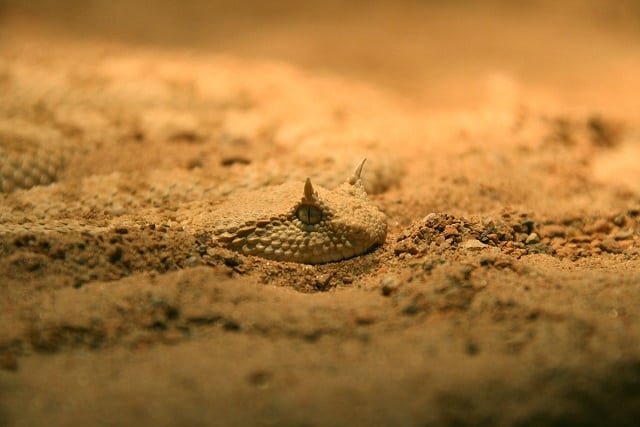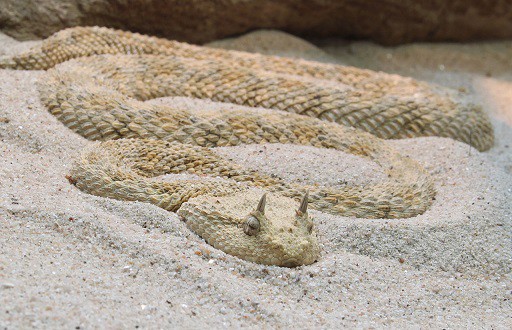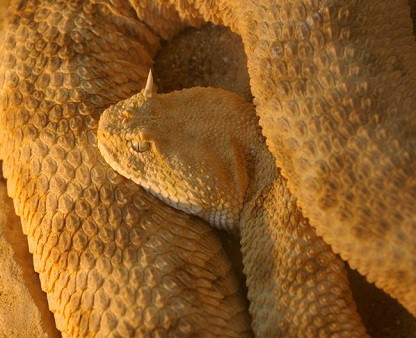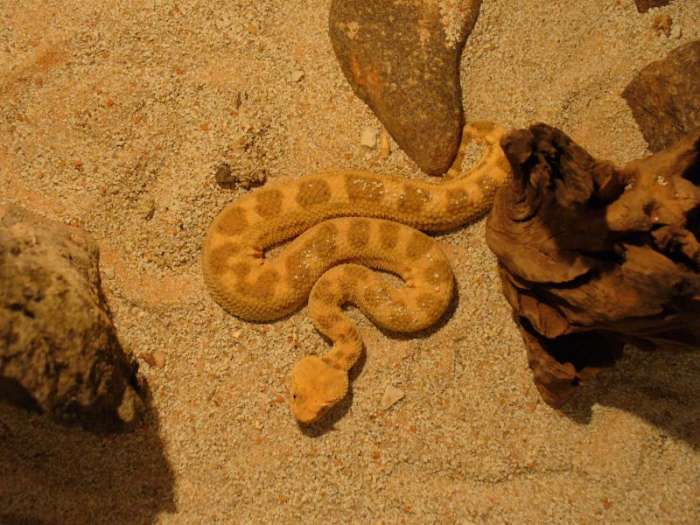| 1 | A north African desert dweller |

If the sight of a local corn snake is too terrifying to cope with, then be thankful that you don’t inhabit the desert regions of North Africa. This region plays host to the desert-horned viper, which could best be described as a sand-diving, spiky horned devil snake.
This species mainly inhabits Morocco, Algeria and Libya, but also stretches into middle eastern countries like Syria and Yemen. Within those boundaries, the desert-horned viper is a creature of rocky deserts and desert valleys. The species can exist in the very driest of climates, the moisture-less sand dunes, but also at the edges of oases. It’s found at altitudes of up to 1500 metres.
This snake is almost never found in human habitation except maybe the most punishing desert army outpost. This isn’t a snake that people regular mingle with, and definitely not a snake which commonly ends up as roadkill like the American corn snake. The species’ evolution is finely tuned for survival in desert locations. They have the ability to store precious drops of moisture from recently eaten prey, and morning dew within their scales. They even have sex while in the sand after burying themselves.
| 2 | A rare horned snake |

Sometimes, it takes being a fully qualified herpetologist to distinguish between different snake species, but not always. The desert horned viper is an easy snake to recognise even by a layman, because of the two clear horns it has on its head.
Unlike the hardened keratin proteins which rhino horns are made from, these devilish horns are extensions of the snake’s normal scales. The horns give this snake a unique silhouette against the setting sun, and are even foldable, flattening against the top of the head as it burrows through underground sand tunnels. They fold when touched by people as well.
As a desert-dwelling snake, it’s theorised that the horns protect their eyes from the harsh glare of sunlight, keeping their vision intact for prowling the sand dunes. But it’s also possible that they use the horns for temptation, to mimic prey species like worms and lure in rodents which the snake later devours.
One of the species’ signature tricks is burying itself in the loose sand dunes up to the eyeballs. They move their rib scales from side to side, moving ever further downward until all that is visible to a passing animal is its horns, and its eyes for seeing.
| 3 | Inspired a mythological beast |

One of the lesser known chapters of Greek mythology is cerastes, a horned serpent of fear. This beast was borne from the blood of Medusa as it spilled in the Libyan desert, the villainess of eternally regenerating heads.
Supposedly, the cerastes had no spine and could curve in endless unnatural directions. It was drawn with the horns of a ram, sometimes with 2 larger horns and 4 smaller ones. According to legend, the Cerastes held a reign of terror over the desert by waiting for travellers to pass by, before leaping out of the sands in a shower of sand particles and sinking its fangs into them. This beast moved in a crooked pattern, supposedly because thousands of years ago, Helen of Troy stepped on its back while eloping with Paris. Its bites were treatable with a healthy dose of spit, but if all else failed, a friend had to lie on top of the victim naked, with the victim also being naked.
After the cerastes myth was created, it became ever more monstrous until some portrayals had it looking like a snarling dragon. But it’s obvious that the original beast was inspired by the desert horned viper. 2500 years ago, the Saharan desert would have felt like a million miles away. The world would have felt huger, and there were probably whispers coming out of travellers returning from the Egyptian desert, which were reasonably accurate at first, yet sounded fantastical enough to the average Greek to be spun into a new chapter of mythology.
| 4 | May have killed Cleopatra |

This species rears its serpentine head repeatedly in Ancient Egypt as well. There’s medical references aplenty, as according to the Oxford Journal of Medicine, Egyptian medical texts from 2200 years ago wrote that the bites were perfectly treatable. There’s also faded paintings of this species on the walls of ancient temples.
However, there’s one particular legend where the horned viper takes centre stage – the death of Cleopatra. She was the ruler of Egypt, astonishingly beautiful, and her skills of seduction were said to be overwhelming. But in 31BC the Roman forces led by Octavius were marching on Alexandria, the city where she dwelt with her lover Mark Antony. He had already killed himself, and when Octavius marched into the city, Cleopatra retreated to her mausoleum. When his men arrived, she lay sprawled on the bed, having committed suicide.
Legend states that she poisoned herself with an “asp” – a common name in Egyptian snakelore which refers to no particular species. The snake suicide was immortalised in Shakespeare’s 1695 play, Antony and Cleopatra, and the species is commonly identified as either an Egyptian cobra or a Saharan horned viper.
| 5 | The snake’s true identity |
It’s not known whether the snake theory is true at all. Some historians believe that Cleopatra used a lethal mixture of palace herbs, possibly hemlock, wolfsbane and opium according to German historian Christoph Shaefer.
Within the snake debate, some believe that the cobra is impossible, because Cleopatra smuggled the snake of doom into her palaces using a fig basket. This would be far too small for a 5-6t feet long cobra, compared to the desert horned viper’s length of 40-60cm. But that accepts the fig basket element of the story as gospel, when it may be another minor element which only appears in myth. Other texts suggest that Cleopatra found the suicide snake slithering around a cave, which is a far more typical habitat of a cobra compared to a horned viper.
Additionally, a cobra’s venom acts far more cleanly. It stops the heart and paralyses the brain, but causes very little damage to the skin surrounding the bite. The horned viper, meanwhile, can cause necrosis and blackening flesh spreading all the way up the limbs. There were no mentions of Cleopatra’s corpse having horrific wounds, but it’s also possible that palace guards hushed up the wounds to preserve the legend of her beauty.
| 6 | Mild yet occasionally deadly venom |

A bite from a desert horned viper has an immediately recognisable effect: a sensation as though your heart is being squeezed by the palm of a hand. Of the viper species, the horned viper is far from the deadliest (that sinister honour belongs to the Russell’s viper of India), but 3% of bites are fatal according to a report from Qatar. Children usually have double the mortality rate of adults. This is a mostly a cytotoxic bite: venom which damages the cells’ walls and contents of those cells. Death typically comes via kidney failure, as the cells rupture and the organ fails to function.
A level 1 bite involves the simple swelling of the tissue surrounding the wound. At stage 2, your skin begins to sweat, your muscles feel weak, and anemia is a possibility. Stage 3 is where things become serious, with blood sugar decreases, coma, and respiratory failure. However, most of these symptoms are curable with rapidly administered antivenin. This isn’t some cursed desert snake where antivenin has absolutely no effect.
Another fun fact is that the cerastes family has its own unique haemorrhagic toxin: cerastase F-4. Another toxin is α/β fibrinogenase, which damages serotonin transportation in the bloodstream.
| 7 | Makes a unique rustling sound |

Unusually, the desert horned viper is completely missing the ability to hiss. The reason is well understood, as hissing requires a voluminous intake of breath, which for this snake would mean a voluminous intake of sand. Instead, the species makes up for it with another prey-intimidating sound: the rustle.
The desert horned viper is one of 4 sidewinding snakes in the world. Instead of slithering forward, it moves directly sideways, with only two small body parts touching the ground, with the goal of minimising contact with the searing desert floor. The scales on its belly are smooth rather than rough, which reduces friction against the sand. In fact, they’re smoother than the sidewinder rattlesnake of Arizona, which probably means that they’ve been evolved for longer.
To produce the rustling sound, horned vipers coil themselves up, and then sidewind on the spot without moving. The rustling is the sound of their scales grinding together. The scales on its flanks are obliquely angled to make this possible, the opposite of their smooth belly scales. Both adults and juvenile members of the species have this special rustling ability.
| 8 | Eats rodents for its sustenance |
This is a snake which prefers mammals for its nutrition. One analysis of horned vipers living in the deserts of Saudi Arabia found a diet composition like this: rodents (70%), arthropods (15%), and lizards (10%). The remaining 5% was unknown, and they deduced those figures by analysing a dead snake’s stomach contents.
One of the species discovered was Cheesman’s gerbil (Gerbilus cheesmani), which is instantly recognisable by its huge, black cartoon-like eyes. Its fur is orange on its back and white on its belly, and its home is the Arabian peninsula. The second species mentioned was none other than Mus musculus, the common house mouse, which has effectively achieved world domination. It’s found from Wisconsin cheese farms to the deserts of Saudi Arabia. This diet was for the Saudi Arabian subspecies (Cerastes c. gasperettii) and its diet will inevitably have subtle differences in other locations.
To hunt down its prey, the horned viper is particularly dependent on its eyesight compared to other snakes. It’s also particularly reliant on vibration sensing, the reverberations of its prey attempting to creep through the desert. Compared to other snakes, it relies on its sense of smell (olfactory senses) significantly less.
There’s one other hunting feature this species is sorely missing: heat-seeking pit organs in the side of its head, which give other snakes a form of infrared vision.
| 9 | Saved from an underground prison |
Across the severely dry desert region of Assa in Morocco, there are hundreds of underground concrete pits, designed to capture water in the short-lived rainy season. Unfortunately, the pits also act as traps for animals. In 2017, wildlife photographer Max Jackson travelled to Assa on a mission to inspect each of these dry, dusty pits in turn.
When he dropped down the ladder into one pit, as captured on video, he discovered a baggy, feeble-looking horned viper. It had been trapped in the pit for an estimated month and had no water to drink, let alone food to eat. Jackson approached, but at first the snake was aggressive and tried to bite him.
Eventually, it calmed down enough to be removed from the pit. Jackson opened his water bottle and poured a torrent onto the half-dead snake’s head. Almost instantly, it began flicking its forked tongue outwards and sucking up water in greedy gulps. The pleasure and relief was visible in the viper’s vertical pupils. Without Jackson’s intervention, it’s estimated that the desert horned viper would have been dead with a week.
| 10 | A fairly small snake |
The largest viper species in the world is the South American bushmaster, at an average of 2 to 2.5 metres. The desert horned viper is only a fraction of that length, being 40-60cm long in adulthood and 12-20cm after birth, even if the snake itself would probably argue that this is better for sneaking up on people. Females of this species are longer than males, but males have a significantly larger head. It’s a vertical pupiled-snake, and if you want to imagine its colour, then think of its habitat; a sandy-coloured yellow mixed with black to light patches.
This snake has a thin neck, with a wide triangular head. Lady horned vipers lay 8-23 eggs at once, which isn’t a massive total (not compared to the boa constrictor with up to 60 young). It’s part of the 70% of snake species which are egg-laying rather than ovoviviparous, which means that they give birth to live young. The eggs are layed under shady rocks or in rodent burrows, and by 2 years of age, the neonates have reached sexual maturity, able to make baby snakes of their own.